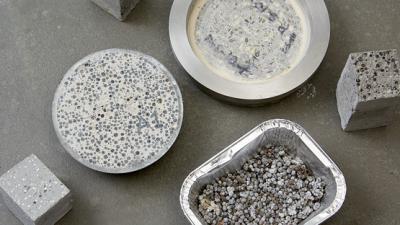Hendrik Marius Jonkers
Self-healing concrete containing bacteria
Finalist for the European Inventor Award 2015
When Hendrik Jonkers was looking for a way to improve the strength and longevity of concrete, he didn’t turn to the steel or stone techniques refined by countless engineers, but instead to an unlikely source for inspiration: the human body.
Thinking about the how bones in the human body are healed naturally through mineralisation from osteoblast cells, Jonkers set about creating a similar self-regeneration technique for our most widely used construction material.
The solution that he landed upon employs a limestone-producing bacteria to close up gaps in concrete. The robust, naturally occurring bacteria ̶ either Bacillus pseudofirmus or Sporosarcina pasteurii, already exist in highly alkaline lakes near volcanoes and seemed tailor-made for the job. They are able to lie dormant for up to 200 years and only begin important repair work only after cracks appear and it comes into contact with water.
Societal benefit
The potential for the patented technology is impressive. Because around 70% of Europe’s infrastructure is comprised of concrete, maintenance is an extremely costly affair. HealCON, an EU FP-7 funded project, estimates the annual maintenance cost for bridges, tunnels and earth-retaining walls in the EU member countries at up to € 6 billion.
Stress under pressure and a high price tag aren’t the only problems with concrete. Anywhere from 7 to 12% of the world’s annual CO2 emissions are related to the production of the building material.
Economic benefit
Jonkers’ self-healing bioconcrete is expected to hit the market in 2015. The main hurdle yet to be overcome is the material’s price, which depends on the application method. With the current method, the production cost is still twice the cost of regular concrete manufacture (€ 80/m3).
A large part of the cost is the expensive calcium lactate nutrient for the bacteria, but Jonkers and his team are well underway to creating a sugar-based nutrient, which would reduce the cost to a level far closer to that for regular concrete (e.g. between € 85/m³ and €100/m3), making it a viable additive and sustainable prevention method.
If Jonkers and his team succeed in overcoming the pricing obstacle, bioconcrete will truly be the concrete of the future, and bacteria will act as slumbering guardians that protect bridges, roads, tunnels and other concrete structures over a 200-year lifespan, only waking up when they’re needed.
How it works
Specially selected types of the bacteria along with nitrogen, phosphorus and a calcium-based nutrient known as calcium lactate, are added to the ingredients of the concrete when it is being mixed. These agents can lie dormant within the concrete for up to two centuries.
When a crack emerges in the concrete, admitting air and moisture, the bacteria awaken and start to feed on the calcium lactate. During the process, they also consume oxygen, and the soluble calcium lactate is converted to insoluble limestone. The limestone solidifies in the cracks, sealing them again.
The technology can seal cracks up to any length provided they have a width of no more than 0.8 millimetres.
The inventor
As a microbiologist specialising in bacteria behaviour, Jonkers joined Technische Universiteit Delft in 2006. His research on bioconcrete is part of a wider project to study the self-healing potential of different materials, such as plastics, polymers and asphalt.
Previously Jonkers worked as a research scientist at the Max-Planck-Institute for Marine Microbiology, Germany, as well as the University of Groningen, Department of Paleontology and the Netherlands Organisation for Applied Scientific Research.
Did you know?
Since 1867, when French gardener Joseph Monier was granted a patent for steel-mesh reinforced concrete, there have been countless innovations using steel to boost the materials strength. One of these was Ann Lambrechts’ method of mixing steel fibres, for which she was honoured with a European Inventor Award in 2011.
Concrete production was a lost art for many centuries. Although the Greeks, Romans and other earlier civilizations used concrete for construction, the technique of using calcium oxide and an admixture to increase the material’s strength was ‘forgotten’ for most of the Middle Ages.
Media gallery
Patent numbers:
Contact
European Inventor Award and Young Inventors Prize queries:
european-inventor@epo.org Subscribe to the European Inventor Award newsletterMedia-related queries:
Contact our Press team#InventorAward #YoungInventors







